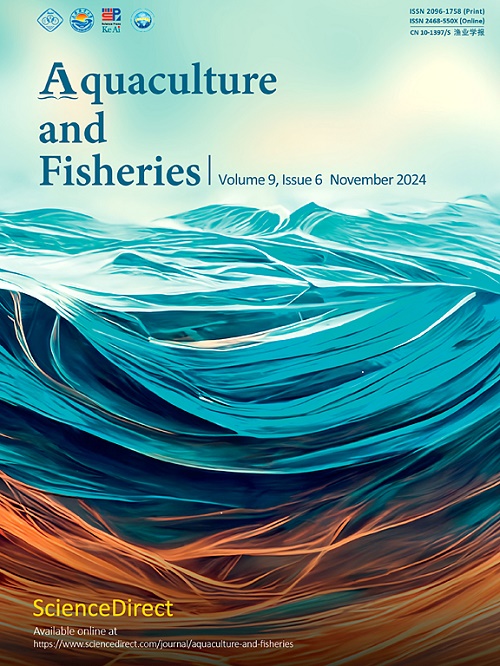Monogamous hybridization of Nile tilapia (Oreochromis niloticus) with Mozambique tilapia (O. mossambicus) results in unprecedented all-female F1 hybrid
Q1 Agricultural and Biological Sciences
引用次数: 0
Abstract
Tilapiine breeding success is season-dependent, with very rare exceptions. The female (f) to male (m) ratio differences showed significant variations in fruitful breeding. Furthermore, the female-to-male ratio in any hybridization protocol involving reciprocal crosses may be the most influential factor in determining breeding seasonality. The innate genetic traits of tilapia, a prominent contributor to global aquaculture production, enable them to easily adapt to a wide range of aquatic environments, rendering them suitable for domestication. The study aimed to determine the breeding timeframe of Nile tilapia (Oreochromis niloticus, N) through interspecific monogamous/two-parent reciprocal crossing with Mozambique tilapia (O. mossambicus, M). Considering preselected genotypic characteristics by PrlLK microsatellite marker, different combinations of hybrid reciprocal crosses were performed in breeding hapa (3 × 3 × 3 cubic feet) inside an indoor plastered cemented tank and then in an outdoor earthen pond facility. Total 11 parental pairs were attempted to propagate inside a cemented tank with (9 pairs) and without (2 pairs) hapa during early April to mid-June. Unfortunately, the trials failed to produce any successful breeding within the schedule. Among those 11 pairs, 6 pairs were Nf × Mm and 5 pairs were Mf × Nm cross. In the earthen pond inside hapa, a total of 18 pairs were attempted where seven breeding successes were reported without demonstrating any dependency for hybridizations over cross types or genotypes and for individuals over sex or species. Successful breeding were reported from the month of May to November. There were few overlapping months of successful breeding for different grouping categories. During the successful breeding period, there were no successful outcomes in both August and October. An inadvertent all-female F1 generation was observed for Mf × Nm crosses, while the reciprocal cross Nf × Mm produced an F1 generation with a nearly 1:1 female to male ratio. The F1 sex ratios exhibited a significant reliance on parental genotypic combinations (p = 5.4e-11). The success stories from different cross combinations would help to frame the breeding protocol for future research. More precisely, for arranging a breeding schedule in freshwater earthen ponds inside hapa for a monogamous/two-parent hybrid cross the study light a close insight.
尼罗罗非鱼(Oreochromis niloticus)与莫桑比克罗非鱼(O. mossambicus)的一夫一妻制杂交产生了前所未有的全雌性 F1 代杂交种
罗非鱼的繁殖成功与否取决于季节,很少有例外。雌(f)与雄(m)之比差异在结果育种上表现出显著差异。此外,在任何涉及反向杂交的杂交方案中,雌性与雄性的比例可能是决定繁殖季节的最重要因素。罗非鱼是全球水产养殖生产的重要贡献者,其固有的遗传特征使其能够轻松适应各种水生环境,适合驯化。本研究旨在通过与莫桑比克罗非鱼(O. mossambicus, M)的种间单/双亲互交,确定尼罗罗非鱼(Oreochromis niloticus, N)的繁殖时间。考虑到PrlLK微卫星标记预先选择的基因型特征,在室内灰泥水泥池和室外泥塘设施中分别进行了3 × 3 × 3立方英尺的杂交正交组合。4月上旬至6月中旬,共11对亲本在有hapa(9对)和无hapa(2对)的胶结池内繁殖。不幸的是,试验未能在计划内产生任何成功的繁殖。其中Nf × Mm杂交6对,Mf × Nm杂交5对。在hapa内的土池中,共尝试了18对,其中7对繁殖成功,没有证明杂交对杂交型或基因型的依赖,也没有证明个体对性别或物种的依赖。5月至11月均有繁殖成功的报告。不同类群的成功繁殖月份很少重叠。在繁殖期,8月和10月均无成功结果。在Mf × Nm杂交中,无意中观察到一个全雌F1代,而在Nf × Mm的倒数杂交中,产生了一个雌雄比接近1:1的F1代。F1性别比例对亲本基因型组合有显著依赖(p = 5.4e-11)。不同杂交组合的成功案例将有助于构建未来研究的育种方案。更准确地说,为了在hapa内的淡水土池塘中为一夫一妻制/双亲杂交安排繁殖时间表,这项研究揭示了一个近距离的视角。
本文章由计算机程序翻译,如有差异,请以英文原文为准。
求助全文
约1分钟内获得全文
求助全文
来源期刊

Aquaculture and Fisheries
Agricultural and Biological Sciences-Aquatic Science
CiteScore
7.50
自引率
0.00%
发文量
54
审稿时长
48 days
期刊介绍:
 求助内容:
求助内容: 应助结果提醒方式:
应助结果提醒方式:


